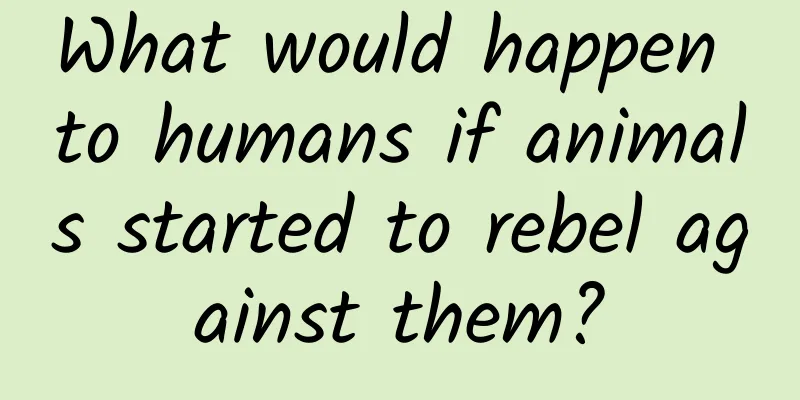What would happen to humans if animals started to rebel against them?

|
This article is based on answering similar questions from netizens, see the screenshot below: To clarify this issue, we must first understand the concept of all living things in the world. Let us learn and share together. What are organisms? How many species are there? In textbooks, organisms are understood as objects with vitality. So what is life? Textbooks also say that it is an open system that has energy metabolism functions, can respond to stimuli, and reproduce. There are many other concepts involved, such as energy, metabolism, etc., which I will not elaborate on here, otherwise it will be endless. We can simply understand that life is a system that can grow by absorbing energy and reproduce offspring through genetic inheritance. Why is this system open? It is because it can interact with the environment and adapt to the environment to continuously evolve. Biology is an object with life characteristics. Of course, the meaning of life and biology is only on Earth. In the vast universe, the environment varies greatly. Can other forms of life or biology evolve? There is no evidence to prove it, nor can it be denied, so we will not discuss it today. How many species are there on Earth? According to biological taxonomy, the biological classification system is a class system, that is, a hierarchical system from large to small. The main framework of biological classification is divided into 8 levels, namely: domain, kingdom, phylum, class, order, family, genus, and species. Species is the basic unit of biological classification. The most closely related species are grouped together into one genus, the next closest genera are grouped together into one family, and so on, eventually all organisms are divided into three major domains. Above the three major domains, all things have the same origin, coming from the earliest life cell. Biological classification is the tree structure of the biological evolution and differentiation process. As biological research deepens, biological classification becomes more and more detailed, and the levels continue to increase. Therefore, sub-classes emerge on the basis of the main classes, such as subclasses and sub-classes under the general class, suborders and sub-orders under the general order, subfamilies under the superfamily, and new units such as stocks, groups, tribes, and groups are added. Does this resemble human organizations? As the division of labor in society becomes more and more detailed, the number of institutions increases and becomes more and more complicated, so streamlining the bureaucracy will always reduce the number of institutions. For example, we humans are all Homo sapiens, and the next level up is the genus Homo, which includes 17 races, of which 16, including Homo erectus and Homo habilis, have all become extinct, leaving only Homo sapiens. The next level up is the subfamily Homo, which includes various extinct ancient humans. The next level up, the family Homininae, includes two subfamilies, namely the subfamily Homo and the subfamily Australopithecus. The superior order of the Hominidae family is the Anthropoidea, which includes various monkeys, apes and humans. It refers to a group of species with advanced intelligence, fingernails, human-like faces, and mostly active during the day. Monkeys are divided into the Macaca family and the Colobidae family. Going up further is the Primates, and the blood relationship with humans becomes increasingly distant. The order Primates governs 2 suborders, 16 families, 78 genera, and 514 species. Humans are derived from primates. Above the order Primates is the class Mammalia, which has three subclasses: Prototheria, Metatheria, and Eutheria, covering about 28 orders and more than 4,000 species. Primates belong to the subclass Eutheria. Above mammals are phyla (subphylum), kingdoms, and domains. These top-level structures are more extensive and comprehensive than the last, but are increasingly becoming the top of the pyramid. According to incomplete statistics, there are about 8.7 million species on Earth, of which about 6.5 million are on land and 2.2 million are in water. As human industrialization destroys the environment, species are decreasing rapidly. According to research and calculations by some zoologists, the current animal species are only one-tenth of the early animal species on Earth. How many organisms are there? The top level of biology is divided into three domains, which are divided according to the cell morphology of the organisms, namely: the eukaryotic domain, the prokaryotic domain, and the viral domain. If all these organisms are added up, the number is impossible to count. The number of species mentioned above actually excludes the prokaryotic domain, that is, bacteria and archaea, and also excludes the viral domain. It is estimated that the total number of bacteria of all kinds on the earth is about 5*10^30, which is 500 trillion trillion trillion; there are about 1.74 million known virus species, but this is only a very small part of the virus species. According to scientific speculation, there may be more than 100 million virus species, and the number is incalculable. Of course, strictly speaking, viruses are not living things, because they are neither dead nor alive. When they find a host, they come alive; in the natural environment, they are just a DNA or RNA molecule fragment, which is dead. The host is a variety of biological cells, including animal, plant and bacterial cells. Now let's talk about the animal kingdom. Animals are divided into vertebrates and invertebrates. There are more than 46,900 known vertebrate species and more than 1.3 million invertebrate species. This is just the known ones. Some people believe that there are actually more than 10 million animal species, including 3 million beetle species. These animals range from ants and mosquitoes to whales and elephants. There are many of each type, and the smaller the animal, the greater the number. For example, ants belong to the class Insecta, subphylum Hexapoda, phylum Arthropoda, kingdom Animalia, domain Eukaryota, and subclass Pterygota, order Hymenoptera, suborder Sphenopoda, family Formicidae. There are at least 15,000 species of ants in the world. How many are there in total? There is no way to count them, but at least there are more than humans, even billions is possible. For example, there are as many as 2,500 species of mosquitoes in the world. No one can tell exactly how many there are, but some people have calculated that there may be as many as 150 trillion during the breeding season; there are even more smaller nematodes, estimated to be 100 trillion; the total number of terrestrial arthropods (including beetles) is about 100 trillion; there are dust mites and earthworms each with as many as 10 trillion. Let's talk about something bigger, like mice. There are more than 450 subspecies of mice in the world, and it is estimated that the total population is about 30 billion. There are about 11,000 species of birds in the world, of which many bird species such as sparrows, house martins, European starlings and ring-billed gulls have populations of more than 1 billion, and the total population exceeds 100 billion. There aren't many large animals left, such as only tens of thousands of wild elephants, about 200,000 bears of all kinds, less than 10,000 wolves, and less than 100,000 hyenas. Wild boars are probably the largest wild animal in the world, with 2 million in China alone and at least tens to hundreds of millions worldwide. Human beings’ unique consciousness determines their dominance over the earth. After hundreds of thousands of years of experience and thousands of years of civilization history, human beings have become increasingly powerful and have firmly occupied the dominant position in the struggle with nature and other species. All this is due to the evolution of human consciousness. Research has proven that humans are the only animals on Earth that have a clear sense of self, memory, and thinking. If humans had not evolved self-awareness from genetic mutations, they would not be where they are today. Consciousness is the general term for self-awareness and thinking memory. Self-awareness is the foundation. Without this foundation, thinking (image thinking and logical thinking) and memory cannot be generated. The so-called self-awareness is the ability to distinguish oneself from others or other creatures. This may seem simple, but it is the most significant breakthrough in human evolution. With self-awareness, humans were able to learn and master the time scale in their long-term observation of nature, gradually forming a complex language based on concepts and having the tools of thinking. From then on, based on self-awareness, people began to use concepts and time scales to mark their feelings and perceptions, forming logical thinking and memory. Humans gradually became a global group with a common language, able to unite and cooperate to understand and transform the world. Fortunately, all other animals on the earth have not evolved a clear sense of self, nor a clear sense of time and complex language concepts. Therefore, they can only bow down to humans. I am not just talking nonsense, but I have scientific basis for this. Some scientists use various methods to test the self-awareness of animals, but very few pass the test. For example, the mirror test is to see if animals know themselves by looking in the mirror. Dogs and cats, which are considered very smart, did not pass the test. Only a few animals such as gorillas, elephants, and dolphins have simple self-awareness. However, these simple self-cognitions have not developed logical thinking and memory, because they do not have language tools and time concepts. For example, the sentence "There will be a thunderstorm tomorrow at noon, everyone should pay attention to safety" contains the time scale: tomorrow at noon, and the concepts: there is, thunderstorm, attention, safety, etc. As long as it is translated, humans all over the world can understand this sentence and respond; but animals have no concept of time and language, and whether they are dogs or gorillas, they cannot communicate such content. It is because human beings have consciousness that they possess a high level of intelligence and are able to dominate the world. If animals start to rebel against humans, what will happen to humans? Many people often think that the animals that cause the greatest harm to humans today are ferocious beasts or larger animals such as sharks. In fact, this is completely wrong. According to research statistics, the animal that ranks first in harming humans is the mosquito. Although mosquitoes are small and can be killed by a single slap, they are found in every corner of the world. It is precisely because of their small size that people cannot prevent them. In summer, they are omnipresent and can bite you if you are not careful. Mosquitoes carry a large number of pathogens that can cause people to suffer from deadly diseases such as dengue fever, malaria, meningitis, and yellow fever. Every year, 200 million people are infected with diseases by mosquito bites worldwide, and more than 600,000 people die from them. The second is poisonous snakes. Every year, more than 5 million people are bitten by poisonous snakes, and at least 100,000 of them die from poisoning. The third is dogs. The number of dogs in the world has reached the number of people, and it is said that there are as many as 7.76 billion dogs, of which there are 200 million stray dogs. Many of these dogs carry rabies virus. Every year, about 25,000 people are bitten by dogs and contract rabies, and the mortality rate of rabies is 100%. However, these harms will not cause extinction to the entire human race, because these animals harm humans instinctively and randomly, not consciously. If animals really develop consciousness, it will be the end of mankind. Not to mention all animals, as long as one animal awakens, humans will be in trouble. For example, the science fiction movie "Rise of the Planet of the Apes" tells the story of a group of apes who begin to gain consciousness, embark on a path of resisting long-term abuse and oppression by humans, and eventually rise up to compete with humans for domination. If some large animals develop consciousness, humans may be able to cope with it because their numbers are small. If a large number of extremely small animals develop consciousness, it will be difficult for humans to cope with it. There is a saying that goes "using an anti-aircraft gun to hit a mosquito", which means that it is useless even if you have the power. If all the ants or mosquitoes in the world develop consciousness, suddenly concentrate on attacking a certain place, and adopt strategies and tactics to attack in an overwhelming manner, it will be difficult for people to escape. If all animals in the world awaken, gain consciousness, and unite to attack humans, a three-dimensional attack will be formed on land, sea, and air, and humans will probably be doomed. On land, all beasts, livestock, poultry, mice, and insects will attack, which is extremely terrifying; if they flee to the sky, they will be sniped by birds; if they flee to the sea, sharks and even fish, shrimp, clams, and crabs will come to share their food; if they flee underground, they will be bitten by mole crickets, cutworms, ants, termites, etc. If bacteria and viruses are added to the mix, it will be too scary. The human body has about 40 to 60 trillion cells, and the number of bacteria in the human body is about 10 times that of the human body. Normally, most of these bacteria do not harm the human body, and some even help the human body. For example, probiotics such as yeast can help the human body digest and maintain intestinal balance. But if these bacteria also have consciousness, receive the attack order, and turn around to attack the human body, the human cells will be destroyed very quickly, and won't they die? Look at the unconscious new coronavirus that is now rampant, which has exhausted humans and caused heavy casualties. There is a movie called "Resident Evil", which tells the story of a zombie virus infecting humans and leading to the destruction of mankind. Plants are a large category of living things. If plants also had consciousness, it would be even more terrifying. They could easily take over the world. A vine could kill a person. If they absorbed toxins from underground and spread them into the air, it would be even harder to guard against. Humans are lucky now because they have a little more wisdom than other animals. But will it always be like this? Will other creatures wake up? Therefore, humans must reflect on themselves and not be too selfish. They must live in harmony with all creatures in order to protect themselves and have a better tomorrow. What do you think? Welcome to discuss, thank you for reading. The copyright of Space-Time Communication is original. Infringement and plagiarism are unethical behavior. Please understand and cooperate. |
<<: Why are the red, green and funds on the health code reversed?
>>: Lose! Hair! Can! Cure! See if you belong to this 90%, come and check your name...
Recommend
Do rattlesnakes have a pair of "eyes" that can sense heat sources?
Do you know about the Sidewinder missile? In the ...
Understand the 4 principles of Zhihu community operation in one article!
In August 2010, Zhihu founder and CEO Zhou Yuan, ...
WeChat plans to launch a paid cloud storage service for chat records, with a minimum price of 130 yuan per year?
Just when everyone had gotten used to using WeCha...
Seven slices of Pinduoduo live streaming
Huang Zheng’s “Disney” is hidden in Pinduoduo’s l...
Why is the annual salary of Gree’s Dong Mingzhu and Lenovo’s Yang Yuanqing 20 times different?
Why is the annual salary of Gree’s Dong Mingzhu a...
Tik Tok Promotion: The Secret of Tik Tok’s Recommendation Algorithm!
Algorithms are an indispensable evaluation mechan...
Alibaba CTO Wang Jian: The era of computing economy has arrived!
Rethinking cloud computing This is the first time...
Advertising overview in May, inventory of top advertisers for App and brand promotion
This article shares with you an overview of the t...
A must-have anti-pitfall manual for operators. Have you fallen into a pitfall?
If you ask operations , what is the most impressi...
How much does it cost to join a restaurant kitchen app in Jixi?
For entrepreneurs, although mini program developm...
The electric car caught fire and ignited the car, both cars were burned to shells
recently In a residential area in Qingyuan Distri...
If I had a hundred eyes, what would I see? - The evolution of eyes from scallops
The winning works of the 2023 "China Science...
Why do some people get diarrhea after drinking milk? It turns out that this is the "trouble"
Many people have had this experience: bloating or...
China's first! Officially released
Recently, my country's first desktop operatin...
How do SEM bidders earn over 10,000 yuan a month?
1. Avoidance (Basics) 1. To avoid dead links, alw...









